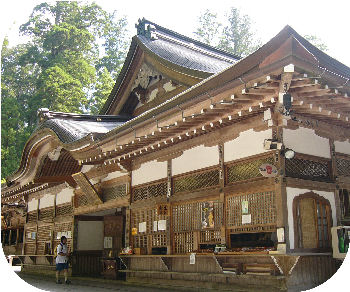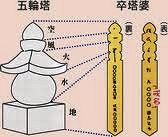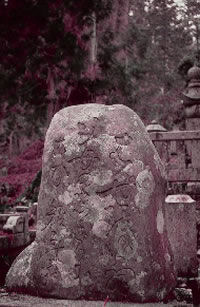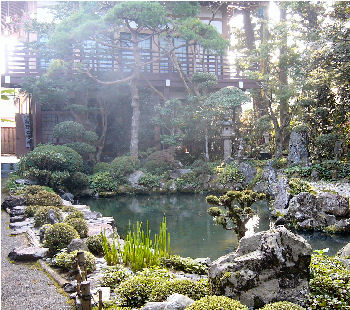|
|
|
|
 |
|
3. Koya-san (Mt. Koya)
August 27 |
|
After Nara Park, we headed for Koya-san (Mount Koya) and there, visited
Okunoin (Inner Sanctuary) and Gobyo (Mouslem of Kobo Daishi, Japanese great
teacher named Saint Kobo), and stayed at the pilgrim's lodging called Hozenin
Temple last night.
As I came here in winter several years ago, both Okunoin and Gobyo were
familier.
Tourou Hall (the hall of lanterns) impressed me with many more dedicated
lanterns lightening than the regular numbers.
The approach to Gobyo was about 2 km from the entrance bridge Ichinohashi.
On the roadside there were a lot of various tombstones of daimyos (Japanese
feudal loads in Edo period and before), and memorial monuments of famous
people, companies and associations. They were said to be over 200,000.
I could see the total sight this time, covered by snow last time. No camera,
because of Sanctuary.
We could not visit Kongobuji Temple, the head temple of Shingon Buddhism.
It was a shame even though we had no time. |
|
As might be expected we felt cool last night here in Mount Koya. How was
it down in the lower world? A night of heat, on the contrary. I wonder
if they could sleep well.
The small haiku poem of Takahama Kyoshi, a famous poet, caught my eye.
"The sky is beautiful on Mount Koya under the flaming sun."
Nevertheless, it is hot as such just before noon.
|
|
A young priest guided us. Though I wondered why he did not have his head
shaved, he was super.
His talk with simple words had a lot of information. It was plain and humorous. In addition, he did not forget the mutual exchange of question and answer.
It will be my responsibility if I do not remember some precious information
from his talk. |
|
 I am confident to remember well his explanation about Gorinto (five-ringed
tower) or a Japanese type of Buddhist pagoda. I am confident to remember well his explanation about Gorinto (five-ringed
tower) or a Japanese type of Buddhist pagoda.
Buddhism preaches "the substances making up the Universe consist of five elements: sky, wind, fire, water and soil".
These elements are shaped as "cube, sphere, pyramid and crescent". Then this shape is called Gorinto or a five-ringed tower. The rings express the idea that after death our physical bodies will go back to their original, elemental form.
Gorinto are usually made of stone, but some built in wood, metal, or crystal
are seen.
Each gorinto is used for memorial or funerary purposes and therefore is
common in Buddhist temples and cemeteries.
 Often offertory strips called "sotoba" of wood with five subdivisions
and covered with elaborate inscriptions can also be found at tombs in Japanese
cemeteries. They are a simplified "gorinto". Often offertory strips called "sotoba" of wood with five subdivisions
and covered with elaborate inscriptions can also be found at tombs in Japanese
cemeteries. They are a simplified "gorinto".
-----
That is about all of my memory. We saw many memorial tombs of "gorinto" and "sotoba" on the approach road. |
|
| There was a haiku monument of Matsuo Basho on the roadside to the inner
sanctuary. |
|
| Chichi Haha no Shikiri ni Koishi Kiji no Koe |
Father, mother dear!
I am mourning for you,
hearing the pheasant's cry. |
|
|
 Basho visited Mount Koya in spring 1688, after the 33rd anniversary of his father's death at Iga-ueno. Basho visited Mount Koya in spring 1688, after the 33rd anniversary of his father's death at Iga-ueno.
This small poem is the one at that time.
In the quiet cedar grove, Basho must have longed for his dead parents by
the voices of a pheasant.
This poem is based on the following waka poem by a priest gyoki in Nara
period. |
|
Yamadori no Horohoro to Koe Kikeba
Chichi ka to zo Omou Haha ka to zo Omou |
Listening to the cry of a pheasant
I wonder:
Could it be my father? Could it be my mother? |
|
|
|
Hozenin Temple
(a pilgrim's lodging)
It was the first time for our couple to stay in a pilgrim's lodging.
We arrived here at 7:00 p.m., just in time for supper from Nara Park. I
was the only person who took a bath before the dinner, but less than 10
minutes.
The sleeping room was suitable to a couple, divided by fusuma (a framed
and papered sliding door used as a room partition) on the both sides. It
was not new nor untidy, and we could see the entrance of Okunoin through
the window. The surrounding view was also in such a quiet atmosphere which
made us feel in a wonderful inn of Mount Koya. There was an old small TV,
but unnecessary for us.
Though the temperature was comfortable, we closed the window, minding the invasion of mosquitoes.
Both supper and breakfast were certainly a vegeterian diet. Every dish
was lightly seasoned, making use of the local materials, which was fresh
to our tongues accustomed to the urban taste.
I drank beer diffidently and enjoyed nothing but tofu dishes. The sesame
tofu was especially delicious.
|
|
Early in the morning from 6:30 to 7:00, we attended the Kingyo (a religious
service).
As cameras were allowed, I took several pictures. I satisfied myself that
I have no ability of photographic technique to express the brisk morning
and the dignity of sutra recitation.

|
|
| Pictures at Okunoin, Hozenin and others |
|
| Part 3 Reading: 9' 25" |
|
|
|
|
|
|
|
| Mail |
|
|